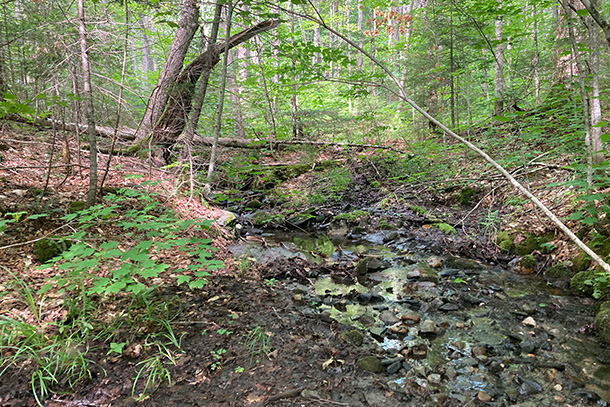
A team of Penn State engineers has determined that both water discharge — or the volume of water flowing through a river or stream — and climate itself may have significant influence on dissolved inorganic carbon concentrations in rivers and streams. The Sleepers River Research Watershed in northeastern Vermont, shown here, is one of the sites in the study with long-term and intensive data records for both surface and subsurface water chemistry. Credit: Provided by Bryn Stewart . All Rights Reserved.
Climate plays large role in carbon release from streams, researchers find
November 22, 2022
By Sarah Small
UNIVERSITY PARK, Pa. — There is a less obvious source of carbon emissions than cars and factories: rivers and streams. Inland waters release carbon in the atmosphere, but their contributions depend on their concentration of dissolved inorganic carbon (DIC) from minerals and other sources. But what factors impact DIC concentrations? A team of Penn State engineers has now determined that both water discharge — or the volume of water flowing through a river or stream — and climate itself may have significant influence.
They published their results in Global Biogeochemical Cycles.
“In this work, we wanted to see how stream DIC concentrations vary across the United States and how they might be impacted by climate and different conditions of different watersheds, like their geology, their vegetation and other land use aspects,” said first author Bryn Stewart, graduate student in environmental engineering in the Department of Civil and Environmental Engineering. “We also wanted to see how the export of DIC varies across different sites and if that is impacted by those different watershed characteristics as well.”
The researchers focused on two scales of analysis, according to Stewart: individual and cross-site carbon export.
To conduct the cross-site analysis, the researchers examined data on mean DIC concentrations, watershed characteristics, climate and mean discharge from more than 100 minimally perturbed rivers across the contiguous United States. For the individual site analysis, the researchers focused on instantaneous DIC concentrations and discharge across the more than 100 rivers and in six additional sites for which they had data on soil carbon dioxide. Instantaneous values represent specific moments in time, providing insight on the short-term dynamics of how DIC is transported.
The researchers found that for nearly all of the individual sites, instantaneous DIC concentrations decrease with discharge.
“DIC is more concentrated at depth, and so it contributes to the stream under those lower flow conditions,” said corresponding author Li Li, professor of civil and environmental engineering in the Penn State College of Engineering. “Then, as discharge increases, you have more water coming from precipitation that flows through the shallow subsurface. The DIC concentrations in the stream will become diluted. We see this universal pattern across the United States, where there is that kind of negative pattern between high concentrations at low flow conditions, and low concentrations at high flow conditions.”
For the cross-site analysis that compared data from more than 100 streams, the researchers found that long-term mean DIC concentrations are higher in arid sites than in humid sites. This indicates that climate has a larger influence on DIC concentrations than previously thought, according to Stewart.
“In the past there's been a much more prominent focus on geology as driving DIC concentrations in streams. While climate has been acknowledged as an important aspect, it has not been seen as the primary factor influencing stream DIC,” Stewart said. “But that's what we've seen in our analysis here: that climate is a major driver of DIC concentrations.”
Site locations further support the finding, Li said.
“We concentrated only on places with minimal direct human impact, like forests, and we can conclude that it's the changing climate and warming, instead of, for example, human impacts such as farming or land development,” Li said. “When the climate become drier, in a lot of places we will see the effect of changing climate on this water chemistry, even without direct human impact.”
The paper’s other authors are Wei Zhi and Kayalvizhi Sadayappan, both in the Penn State Department of Civil and Environmental Engineering, and Gary Sterle and Adrian Harpold of the Department of Natural Resources and Environmental Science at the University of Nevada Reno. The National Science Foundation, the Johnsons Fellowship in Environmental Engineering, and the Graduate Fellowship from Penn State Graduate School funded this work.



